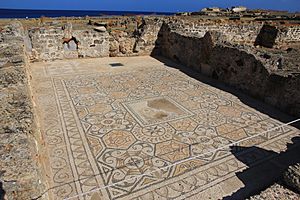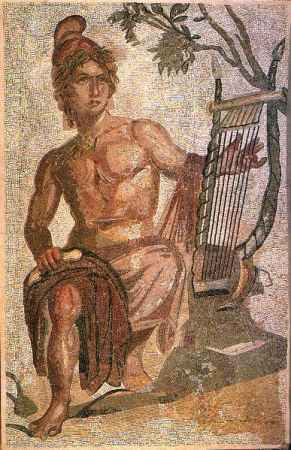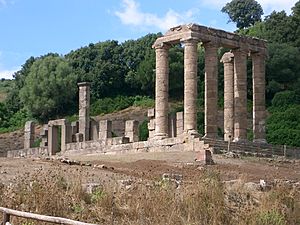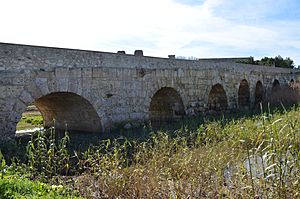Sardinia and Corsica facts for kids
Quick facts for kids Provincia Sardinia et Corsica |
|||||||||
|---|---|---|---|---|---|---|---|---|---|
| Province of the Roman Empire | |||||||||
| 238 BC–AD 455 | |||||||||
 Province of Sardinia and Corsica within the Empire (125 AD) |
|||||||||
| Capital | Carales | ||||||||
| Area | |||||||||
| • Coordinates | 39°15′N 09°03′E / 39.250°N 9.050°E | ||||||||
| History | |||||||||
|
• Roman annexation
|
238 BC | ||||||||
|
• Split into two provinces
|
AD 6 | ||||||||
|
• Capture by Vandals
|
AD 455 | ||||||||
|
|||||||||
| Today part of | France Italy |
||||||||
The Province of Sardinia and Corsica (Latin: Provincia Sardinia et Corsica) was an ancient Roman province that included the islands of Sardinia and Corsica. These islands are located in the central Mediterranean Sea.
Contents
Life Before Roman Rule

The Nuragic civilization was a thriving culture in Sardinia from about 1800 to 500 BC. The ancient Sardinians, also called Nuragics, traded with many different groups around the Mediterranean Sea. This happened during the Bronze Age and early Iron Age. They traded especially with the Myceneans and people from Cyprus.
The Sardinians built many towns along the coast, like Nora and Tharros. They also built special tower buildings called nuraghes, which the island is famous for. A similar culture, the Torrean civilization, grew in Southern Corsica. They built several torri, which are similar towers.
The ancient Sardinians had a complex culture. They built large holy places where Nuragic communities gathered for special events. They could organize big projects, like building beautiful temples and water systems. These included fountains and aqueducts. They even created life-sized statues. This was impressive because they did not have a strong ruling class or much social division.
Later, the Phoenicians set up trading posts on the coast of Sardinia. Sardinians and Phoenicians lived together in these coastal towns. The Greeks also came and started colonies. These included Alalia in Corsica and Olbia in Sardinia.
The Carthaginians, who were connected to the Phoenicians, took over Alalia in 535 BC. They had help from the Etruscans. After Corsica, parts of Sardinia also came under Carthaginian control.
How Rome Took Control
While Carthage was busy with another war, Rome broke an earlier agreement. Rome took Sardinia and Corsica by force. In 238 BC, the Carthaginians gave up their claim to the islands. The islands then became a Roman province. This was the start of Roman power in the western Mediterranean. The Romans ruled this area for 694 years.
However, the Nuragic Sardinians and Corsicans often fought against Roman rule. A rebellion started in 235 BC. But it was put down by Manlius Torquatus. Other revolts happened in 233 BC and 232 BC, and the Romans stopped them.
In 231 BC, armies were sent to each island to deal with the unrest. But these efforts did not fully succeed. A large rebellion, called Bellum Sardum, happened during the Second Punic War in 216 BC. A Sardinian leader named Hampsicora led this big revolt. He had an army of local people and Carthaginian allies.
The 100s BC was a time of trouble in the province. In 181 BC, the Corsi people, who lived in southern Corsica and northeast Sardinia, rebelled. The revolt was stopped by Marcus Pinarius Posca. In 177/176 BC, the Roman Senate sent a large army to stop a rebellion by Sardinian tribes. Around 27,000 Sardinians died in this revolt. After their defeat, the islanders had to pay double taxes.
More revolts happened in 174 BC and the next year. In 163 BC, another revolt was put down. Two more revolts broke out in 126 and 122 BC. They were stopped by Lucius Aurelius. The last major uprising happened in 111 BC. It was put down by Marcus Caecilius Metellus. After this, the Sardinians living near the coast stopped rebelling. But people in the highlands continued to fight the Romans from time to time. They became known as civitates Barbariae.
Sardinia and Corsica in the Roman Empire
In the late Roman Republic, important Roman leaders like Gaius Marius and Lucius Cornelius Sulla Felix settled their soldiers on Corsica. They used the islands' grain to help their wars. Julius Caesar also took control of the islands from Pompey. This gave him control of the grain supply, which helped his army win the civil war in 49 BC.
Later, Octavian (who became Emperor Augustus) received the islands. He used their grain to feed his armies. Between 40 and 38 BC, Sextus Pompey, Pompey's son, and his admiral Menas took over Corsica. They used a large pirate fleet to cause trouble in Sardinia, Sicily, and even Italy. Sextus Pompey's fleet was so strong that Octavian had to make peace with him. In a treaty in 39 BC, Sextus Pompey was given Corsica and Sardinia. But conflict started again in 38 BC. Octavian then built a powerful fleet and defeated Sextus Pompey.
In Augustus's changes to the provinces in 27 BC, Sardinia et Corsica became a senatorial province. This meant it was managed by the Roman Senate. In AD 6, Corsica became a separate province. Sardinia was kept as one of Augustus's personal provinces because it had a large army base. Even when Sardinia returned to the Senate in AD 67, the two islands stayed separate provinces.
The provinces of Corsica and Sardinia became part of the Diocese of Italy in 292 AD. This was done by Emperor Diocletian.
How Romans Saw the Islands
Romans settled in the coastal areas of both islands. They adopted the Latin language and Roman culture. But the people in the inner parts of Sardinia and Corsica resisted the Romans. Many revolts happened. The Romans mostly avoided these inner areas because they were heavily forested. They called these areas Barbaria, meaning "land of the barbarians."
Overall, Corsica and Sardinia were not as important to Rome as other places like Roman Egypt. Romans often thought the islands and their people were undeveloped and unhealthy. This was probably because of malaria, a disease that was common there. A study in 2017 showed that malaria was present in Sardinia over 2,000 years ago.
Romans did not get much wealth from Corsica. The people there were also not eager to learn Roman ways. A writer named Strabo described Corsicans as wild people who lived by stealing. He said that buying a Corsican slave was a waste of money because they were not helpful. Sardinian slaves also had a bad reputation. They were seen as untrustworthy and might even harm their owners.
After a Roman victory over a rebellion, many Sardinian captives were sold as slaves. They were so common that the saying Sardi venales ("Sardinians for cheap") became popular. It meant something was cheap and worthless, as reported by Livius.
Cicero, a famous Roman speaker, said that Sardinians were "worse than each other." He called the rebels from the highlands "thieves with rough wool cloaks." He also compared Sardinians to the ancient Berbers of North Africa. He said that no Sardinian city had ever been friendly to the Romans.
Another Roman writer, Varro, also compared Sardinians to a Berber tribe. He said that some groups, like those in Getulia and Sardinia, wore clothes made of goat skins.
Many of these negative ideas came from the Sardinians' strong dislike of Rome. Their frequent rebellions lasted for centuries. Even in the 1st century BC, when most of the island was under Roman control, the Sardinian highlands were often in turmoil. Strabo noted that mountain people were still not fully peaceful in his time. They would steal from other Sardinian communities and even raid the coast of Etruria. They often committed acts of piracy against the city of Pisa.
However, some Romans had good opinions of Sardinians. For example, Caesar was friends with a Sardinian singer named Tigellius. The city of Carales supported Caesar and helped him with troops during a battle.
Life in the Roman Province
Corsica and Sardinia were not heavily developed with many cities. They were often used as places to send people into exile. For example, Gaius Cassius Longinus, a lawyer, was sent to the province. Many Jews and Christians were also sent to the islands under Emperor Tiberius. Christians were often exiled to Sardinia to work in its rich mines or quarries.
Even though they were sometimes overlooked, the islands played an important part in the Roman Empire. Sardinia provided Rome with much of its grain supply during the Roman Republic. Corsica provided wax. Also, Sardinia provided the most sailors to the Roman military fleets among all the western Roman provinces.
Sardinia was also a main supplier of metals to the Roman world. It had rich silver, lead, and copper mines. Sardinia was the third-largest producer of metals among all Roman provinces, after Britain and Hispania. During Roman rule, it is thought that about 600,000 tons of lead and 1,000 tons of silver were produced.
Only a few Sardinians became Roman senators or knights during the time of the Empire. One Sardinian, Marcus Erennius Severus, became a governor in Judea.
Important Cities
Carales, known today as Cagliari, was the largest city in the province. It had about 30,000 people. It had been a city since at least the 8th century BC. A Roman writer called it urbs urbium, meaning "the city among cities." Carales came under Roman rule in 238 BC. During the Second Punic War, it was a main base for the Roman general Titus Manlius Torquatus. The most important Roman buildings still visible are its amphitheater, which could hold 10,000 people, and the ruins of a Roman villa.
Sulci was another large city in Sardinia. It was founded around the 9th century BC. It became one of the biggest cities under Carthaginian control. This is shown by its huge burial ground with over 1,500 underground tombs. By the 5th century BC, it had about 10,000 people. In 258 BC, a naval battle happened nearby. Sulci became wealthy because it was close to rich lead mines.
Nora, near the modern city of Pula, was thought to be the oldest city in Sardinia. An ancient Phoenician text found there shows it was an important port as early as the 9th century BC. Today, you can still see beautiful Roman mosaics and a well-preserved Roman theater there.
The city of Tharros, on the western side of the island, was a main producer of jewelry in the Carthaginian world. This is known from the rich items found in its burial sites. It was one of the cities that rebelled against Roman rule during the Second Punic War.
Olbia, on the northeastern side of Sardinia, was a rich port town. Even though its name sounds Greek, the Carthaginians controlled it by the 5th century BC. Its large walls, still visible today, were built in the 4th century BC. When the Romans took the island in 238 BC, Olbia became an important naval base. Like other major Roman cities, Olbia had public baths and a forum. Other notable cities included Othoca, Neapolis, Bithia, and Cornus, the home city of Hampsicora.
The Romans also founded new towns called colonies. The two main ones were Turris Libisonis and Forum Traiani. Turris Libisonis, in the northwest, grew wealthy because of its fertile plains and good port. Its impressive baths and mosaics are still well preserved. Forum Traiani was in the fertile Campidano area. It was known for its baths, which were believed to have healing powers.
The most important city in Corsica was Aleria. It was founded in the 7th century BC by the Phocaean Greeks. It was later taken by the Etruscans. Aiacium also started as a Phocaean port. Gaius Marius founded Mariana in northern Corsica in 93 BC.
|
See also
 In Spanish: Córcega y Cerdeña para niños
In Spanish: Córcega y Cerdeña para niños





